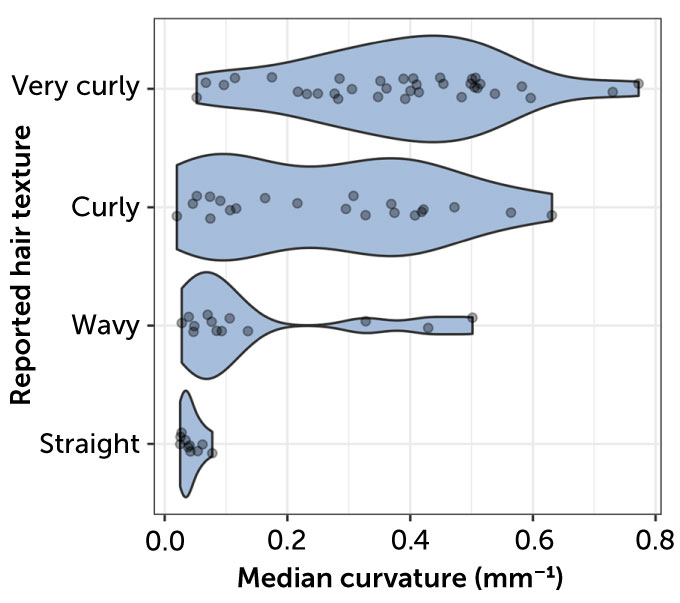
Though humans’ nearly hairless bodies stick out like a cowlick among other primates, our nakedness isn’t unique in the world of mammals. Dolphins and whales are naked, says biological anthropologist Tina Lasisi of the University of Southern California in Los Angeles. There are naked mole-rats. “Elephants, depending on how you look at them, are kind of naked,” she says. “But we’re the only weirdos that are naked except for our head.”
Our species traded off much of our body hair for more sweat glands, an evolutionary adaptation that helps us regulate body heat more efficiently. But what about another uniquely human feature? We’re the only animals known to express tightly curled hair, like that seen in many people of African descent. Lasisi wants to know why and how it came to be.
Backstory
For decades, traits that have been associated with racial categories, such as skin pigmentation and hair texture, have gone understudied or ignored among anthropologists, Lasisi says. Much of the study of human biological variation was deserted after the post–World War II backlash against eugenics, a racist field birthed from the idea that humankind could be improved if those deemed to have desirable traits were selectively allowed to reproduce. Since then, research on human variation has largely focused instead on traits that are not overtly racialized, such as lactose intolerance and adaptations to high altitudes.
But studying all forms of human variation is crucial to understanding our species’s evolution, Lasisi says. Studying variation in a way that normalizes rather than dampens or paints differences in a bad light is key not only to righting anthropology’s harmful legacy, but also ethical, socially responsible and sound science, she says.

Sign Up For the Latest from Science News
Headlines and summaries of the latest Science News articles, delivered to your inbox
Client key* E-mail Address* Go
Thank you for signing up!
There was a problem signing you up.
Lasisi discovered biological anthropology as an undergraduate student at the University of Cambridge. As a Black person who spent many of her formative years among white people in the Netherlands, she was always aware of skin color. She vividly remembers learning that human skin pigmentation evolved as an adaptation to ultraviolet radiation — research pioneered by anthropologist Nina Jablonski of Penn State, who would later become Lasisi’s primary adviser. “It’s like a lightbulb went off in my head,” Lasisi says, and it made her wonder, “What else out there can be explained by evolution?”
Her interest in the origins of curly hair grew in part as an effort to understand her own locks. “Research is me-search,” Lasisi says. But when she first began, there wasn’t much science to comb through, and methodologies for measuring hair texture were either unreliable or inefficient.
Standout research
As part of her Ph.D. research, Lasisi worked with a team of anthropologists, thermal engineers and physiologists to study how curly hair might have given our bipedal ancestors a leg up in the hot and dry African savanna.
The team placed a variety of wigs made of human hair onto heat-sensing models and measured heat transfer in different environments. In dry settings, curly hair, especially tightly curled hair, protected the scalp from solar radiation while releasing more heat from the head than straight hair. Lasisi speculates that the larger amount of air space within curly hair is what does the trick.
To underpin her efforts and support future hair research, Lasisi developed an improved and standardized way of measuring hair curvature and cross-sectional shape. The technique involves segmenting, washing and taking pictures of hair strands and then running the images through an open-source computer program that she created.
Measuring these characteristics on a continuous spectrum (much like we do height, for instance), she argues, is a better way of studying hair texture than the long-standing practice of classifying hair into discrete categories, such as straight, wavy or curly. Such discrete categories are not standardized among experts and can become subjective, she says. They also obscure the immense variation that exists, even on a single person’s head, and especially among curly hair.
Cloudy categories
Hair with similar curvatures can be perceived as straight, wavy or curly, as seen in this figure that compares the self-reported hair texture of 140 people of European and African ancestry with the actual curvature of their hair samples.
Self-reported hair texture vs. measured curvature T. Lasisi et al/Scientific Reports 2021T. Lasisi et al/Scientific Reports 2021
T. Lasisi et al/Scientific Reports 2021T. Lasisi et al/Scientific Reports 2021
Lasisi is doing highly technical work that hasn’t been part of the conversation, says Robin Nelson, a biological anthropologist at Arizona State University in Tempe. “Before Tina, very few people were working on hair texture in the same way.”
Lasisi will bring this experience to the University of Michigan in Ann Arbor as an assistant professor in 2023, where she’ll continue her studies on human variation.
Reaching out
Lasisi wants everyone to be included in conversations about what makes humans human. She has appeared on the podcast Getting Curious with Jonathan Van Ness (of Queer Eye fame). She also hosts a PBS digital show on human evolutionary biology called Why Am I Like This?, which she helps conceptualize and write.
What’s more, Lasisi has cultivated a community of curious science seekers on Twitter, Instagram and TikTok. Through short-form videos marked by her signature wit and humor, such as her “Melanin March” series or “Darwin’s greatest hits against white supremacy,” Lasisi educates thousands of followers on human variation, how to talk about race and ethnicity from an anthropological perspective, and much more. She even gives prospective anthropologists career tips and behind-the-scenes glimpses of life in academia. Two-way discussions let her learn from her audience, which she calls her “little focus groups.”
@tinalasisi
#MelaninMarch is off to a late start but it’s here #LearnOnTiktok
♬ Candy Crush – David Das
In a series of videos on TikTok, Tina Lasisi introduces viewers to melanin, its different types and what it’s got to do with squid ink, mushrooms and watermelons.
Lasisi hopes her research and outreach will inspire and provide a helpful framework for more nuanced discussions about race, ethnicity, ancestry and human diversity — and that her visibility as a Black anthropologist will encourage other people of color to ask questions that are important to them. “I want to put enough information out there in the world, and [have] enough people out there in the world who have a grasp of that information,” she says, “so that we can see human variation for the beautiful, magnificent, complex thing that it is.”
Want to nominate someone for the next SN 10 list? Send their name, affiliation and a few sentences about them and their work to [email protected].

